What is a Drive Axle?
Introduction
A drive axle is a split axle with universal joints (UV joints) and a differential between the two half axles. It is a key component to a vehicle's drivetrain and refers to the axle or drive shafts of the vehicle's driving wheels. Components that make up a drive axle may also be considered as components for other drivetrain systems; as virtually all drivetrain components work together to make a vehicle move.
That being said, those not too familiar with how a vehicle works may find it easy to mistake a drive axle with other key components that make up a vehicle's drivetrain. Before one can learn more about drive axles and how they work, it is important to understand the several components that make up the entire drive axle itself such as:
- Axle
- Shaft (Drive Shaft)
- Differential

What is an Axle?
The drive axle is a crucial car component that extends out from the differential and into the tire. Typically, drive axles are encased within an axle housing, which offers the part more protection and allows it to operate much more efficiently. They can be found on both front or rear wheel drive vehicles and are necessary to operate both the front axle and the rear axle. It’s likely that you already know about the drive axle without even realizing it as the CV axle, or Constant Velocity axle, can technically be considered a drive axle. CV axles act identically to drive axles as they both transmit power from the transaxle out to the tire.
Before jumping straight into the details surrounding any axle assembly, it’s important to first discover the axle definition itself. An axle is a rod or spindle that passes through the center of a wheel or group of wheels. An axle's rod or spindle can be designed to either remain in a fixed position or to rotate depending on what type of vehicle the axle was designed for. Axles are classified as either a live axle or a dead axle. Dead axles can also be referred to as a "lazy axle." When it comes to a car axle, the axle may be set up in the following two options:
- The axle is fixed to the wheels. When fixed on the wheels, the axle is able to rotate along with the wheels as it supports each revolution.
- The axle is fixed to the vehicle. When fixed on the vehicle itself, the wheels on the vehicle will rotate around the axle rather than with the axle.
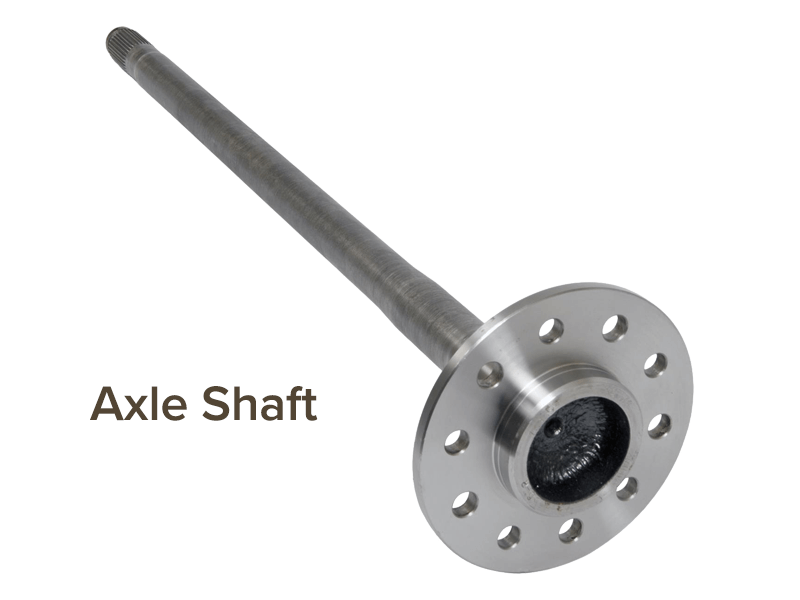
Live Axles
Live axles are used to transmit power throughout the component. They are responsible for driving the wheels that they are attached to. Despite being designed as a moving part, some live axles may also be used to support the weight of the vehicle. When examining a front wheel drivetrain, live axles are responsible for steering the vehicle. Depending on the vehicle, some may utilize a live rear axle that is also responsible for steering.
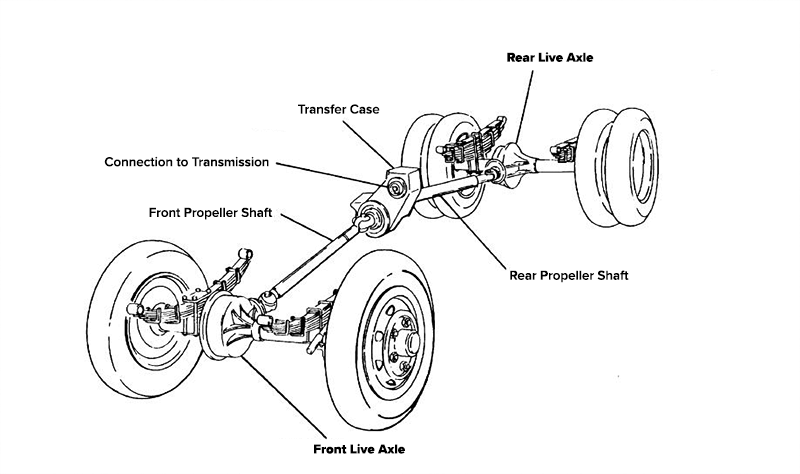
The most common type of passenger vehicles contain live axles only in the rear of the assembly, while in a four-wheel drive vehicle, both the front and rear axles are live. Six-wheel drive vehicles contain three axles which are all live axles.
Dead Axles
Dead Axles are used solely as a support for part of the vehicle while providing a mounting for the vehicle's wheel assembly. Typically, dead axles are found in the front area of commercial trucks and truck-tractors. Almost all common passenger vehicles lack a front axle, as they utilize independent front-wheel suspensions. It is uncommon for a commercial vehicle to rely on a dead axle.
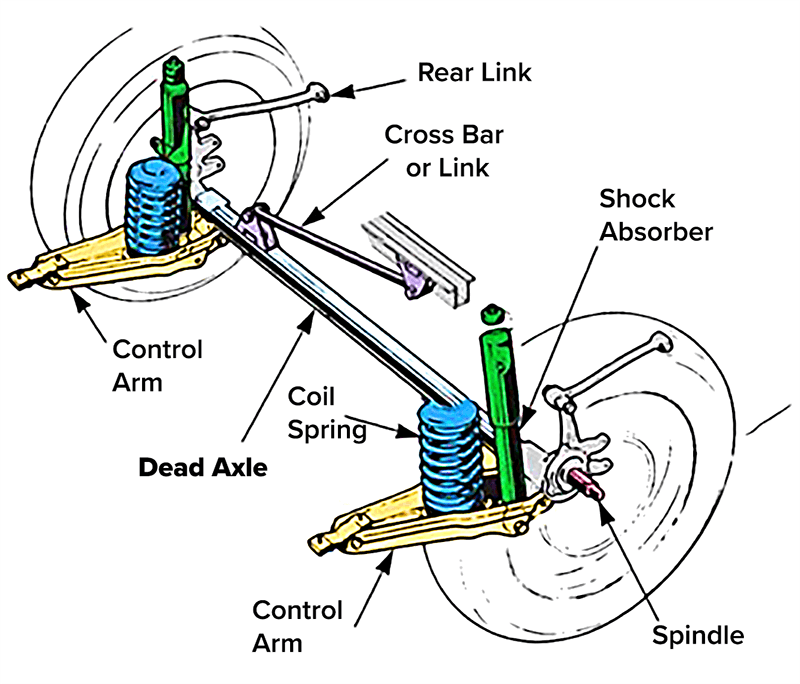
A dead axle is technically not included in the parts that make up a drivetrain and does not have a differential attached to it, as it is a free rotating axle that is only utilized when there is a large amount of weight placed on it. They mount wheels, bearings and even gears in some drive axle setups.
Dead axles remain in sync with the drivetrain itself and are crucial for commercial vehicles that utilize them. Despite not transferring power like live axles do, their importance lies with their responsibility to carry the wheel itself.

Axle Housing
Axle housing cases are manufactured in either a one-piece or split construction. An axle housing with a split design is commonly referred to as "banjo housing" by many, as they bear resemblance to a banjo instrument. Both the front and rear openings of the axle housing are provided in the center housing. The differential carrier closes the front opening, while a spherical cover plate covers the rear opening.
It is responsible for carrying the weight of a vehicle and is typically an extremely heavy component. Heavy-duty trucks and truck-trailers possess axle housing that is heavier than the housing found in common commercial vehicles, as they are designed to transport heavy weight.
The axle housing in light-duty trucks may be a combination of cast iron and cast steel tube. The differential and final drive cases are generally a cast and machined unit, while the axle housing itself is welded or extruded steel tubing.
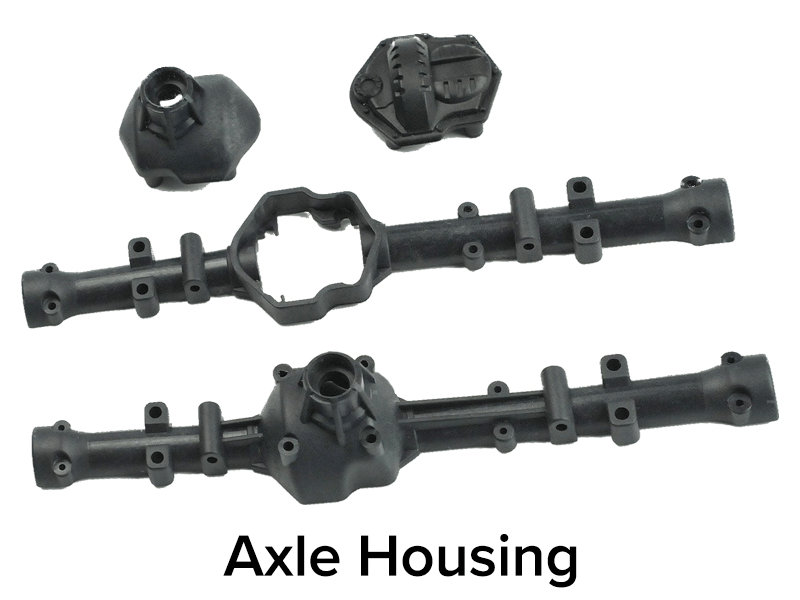
There are several components that may be welded into the axle housing itself, such as: mounting flanges, braking plates, spring mounting plates and any accessory units that a mechanic or driver may want to install into the housing. These components are typically replacement or upgrade seals or plates that that are installed by a third-party.
Additionally, vents or valves are installed on top of the housing to prevent pressure from building up, which develops from heat within the housing. Heat is produced from normal operation of the vehicle, and these vents or valves release the heat. If the pressure is not released from the housing, it may force the axle lubricant to move past the rear wheel oil seals and damage the vehicle's brake linings. Despite allowing air to pass through the housing, these vents prevent debris and dirt from entering.

What is a Shaft?
It is common for the term "shaft" to be used interchangeably with "drive shaft," "CV shaft" and "axle," as it is a rotating rod within the axle's housing responsible for transferring movement or torque throughout the assembly it was designed for. In most vehicles, a drive shaft is connected to the transmission on one end and the differential on the other. The transmission transfers power to a differential via the drive shaft. In addition to transferring power, shafts may also receive power, or both simultaneously. This can be seen in vehicles that utilize all-wheel drive.
An entire axle assembly typically contains two half shafts located on each side of the differential. They are connected to the wheel bearing and allow the wheel to rotate. They may also be found in machines that require physical components to rotate, such as gears.

What is a Differential?
A differential is a gearing found between each half shaft on the car axle that is connected to the wheel. The wheels on a vehicle traveling on any specific path must all travel at different lengths throughout the entirety of the journey. Since wheels operate in this way, it is necessary for each wheel to have the ability to rotate at a different speed from one another. Differentials allow each wheel to turn at a different speed.
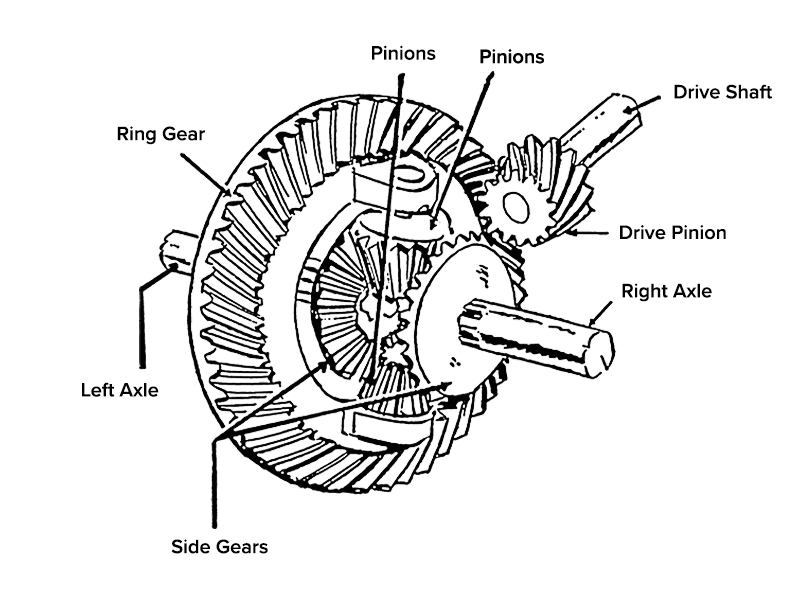
A pinion gear is attached to the end of a drive shaft and rotates to turn the differential's ring gear. The ring gear is responsible for rotating side gears, which ultimately enables the two axles to turn at different speeds.
The speed of rotation for axles on vehicles traveling in a straight line remains consistent until the vehicle makes a turn. As the vehicle turns, the differential compensates for the axle's need of a different speed; thus, allowing the vehicle to operate and turn properly.

What is a CV Joint?
Universal joints that connect the drive axle are called constant velocity joints. These joints are typically referred to as CV joints. The outer CV joint is a ball and cage that remains in a fixed position. The inner CV joint is called a plunging (sliding) ball and housing. It can also be referred to as a tripod-type joint. These types of inner CV joints act like a slip joint in a drive shaft for a rear-wheel drive vehicle.
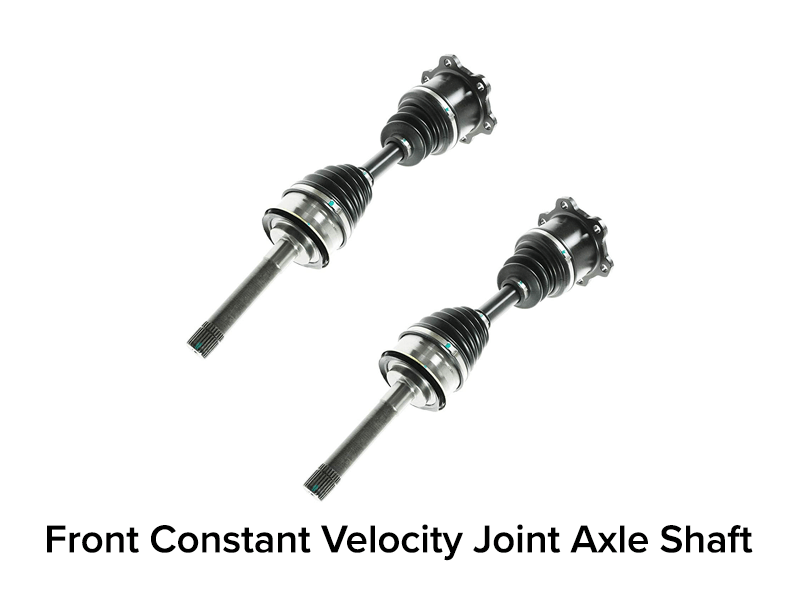
The plunging action that takes place within an inner CV joint allows for a change in distance between the transaxle and the wheel hub. The length of the drive axle must change as the front wheels of a vehicle move up and down over bumps on the road.
Overtime, this movement can cause wear and tear on the CV joints which result in the need for a replacement. Depending on the vehicle's configuration (AWD, FWD, etc.), a new CV joint can cost anywhere from $350 to $850.

Front Drive Axle
A front drive axle relies on the power that is transmitted to it from the transfer case via the drive shaft to steer the wheels of a vehicle. Certain vehicles that utilize a front drive axle may have the differential housing set off center in the axle housing to allow the drive shaft to pass beside the engine oil pan and maintain adequate road clearance without excessive height at the front of the vehicle.
Universal joints, which are located on the outer ends of the axles, are used to allow the front wheels and hubs swivel while still transferring power to them respectively. UV joints are necessary as the front wheels on a front drive axle must turn on the axle spindle arm pivots by the axle shaft itself.
Vehicles that utilize a four-wheel drive axle require locking hubs for the front drive axle to function properly — locking hubs transfer power from the driving axles to the driving wheels on four-wheel-drive systems.
There are three basic types of locking hubs:
- Manual Locking Hub - A manual locking hub requires the driver to turn a latch on the hub itself which locks it and shifts the vehicle into four-wheel drive.
- Automatic Locking Hub - An automatic locking hub is a hub that locks the front wheels to the axles when the driver shifts the vehicle into four-wheel drive.
- Full-Time Hub - A full-time hub are hubs that are always locked and drive the front wheels of a vehicle.
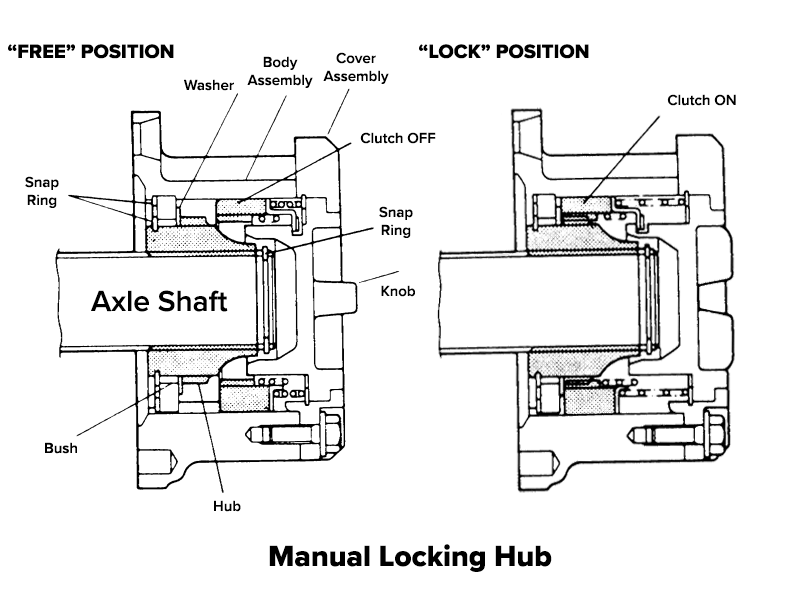
Manual and automatic locking hubs are the most common locking hubs found on most vehicles. They enable vehicles with four-wheel drive to temporarily switch into two-wheel drive. This is beneficial for vehicles driving on dry pavements, as the front wheels can turn without turning the front axles. Enabling this function via the locking hubs provide the vehicle with increased fuel economy as well as reduced driveline wear.

Rear Drive Axle
Rear drive axles are responsible for connecting the differential side gears to the drive wheels. Depending on the vehicle and the drive axle it utilizes, the rear drive axle may or may not be used to support the vehicle's weight. Typically, they are manufactured with harder materials than other drive axle components, as this allows an increase in strength. Rear drive axles can be categorized into three types - semi-floating, full-floating, and three-quarter floating.
Semi-Floating Rear Drive Axles
Semi-floating rear drive axles are found in common passenger vehicles and light trucks. The shaft and housing support the weight of the vehicle. The side gears of the differential are used to carry the inner end of the semi-floating rear drive axles to relieve the axle's shafts of the differential's weight. Also, it relieves the shafts from the stress caused by normal operation within the axle housing.
The inner ends of the axle only transfer turning effort or torque and they are not acted upon by any other force during the vehicle's operation. The outer end is supported by a bearing located between the shaft and the housing. The load is transferred through the use of a tapered roller.
The axle shafts take the stresses caused by turning, skidding or wobbling wheels. They are flanged or tapered on each end. When using a tapered axle, it is most common for a brake drum and hub to be pressed onto the shafts. When this occurs, keys are used to prevent the assemblies from turning on the shafts. Other vehicles with a less common tapered axle have serrations or "splines" on the outer ends of the shafts rather than the more common brake drum and hub setup.
Both of these setups serve the purpose of disconnecting the wheel from the vehicle itself in the event of the axle breaking. Should the axle break during operation of the vehicle, the action of disconnecting the wheel itself assists the vehicle with not only coming to a complete stop but with the prevention of damaging the drive axle further.
Full-Floating Rear Drive Axles
Full-floating rear drive axles are used in heavy-duty trucks. A pair of tapered roller bearings carry the outer end of the axle housing. These bearings are located outside of the axle housing. This results in the axle housing taking the full weight of the vehicle. It also results in the axle housing absorbing all stresses or end thrust caused by turning, skidding or pulling.
Torque from the differential is transmitted only by the axle shaft in full-floating rear drive axle setup. The axle shaft is connected to the drive wheel through a bolted flange, which allows it to easily be removed for servicing without the need to remove the wheel.
Three-Quarter Floating Rear Drive Axles
A three-quarter floating rear drive axle is a less common type of rear drive axle used on older commercial vehicles. It is a combination of the full and semi-floating axle. The outer end of the axle shaft is supported by a bearing and is moved from inside of the axle housing to the outside. This mounting setup places most of the weight of the vehicle on the ends of the axle housing rather than the ends of the axle shafts.
The wheel is securely keyed to a taper on the end of the axle shaft. With that said, side-thrust that occurs is still taken by the axle shaft as the vehicle skids or turns.

Two-, Four- & All-Wheel Drive Axles
It is common to mistake a four-wheel drive (4WD) axle configuration with an all-wheel drive (AWD) axle, as both configurations transfer power to the four wheels of a vehicle. Two-wheel drive (2WD) axle configurations, which can consist of either a front wheel drive (FWD) or rear wheel drive (RWD) axle setup, are more common in passenger vehicles. FWD is more common than RWD in passenger vehicles.
Front Wheel Drive Axles (FWD)
FWD axles transfer power from the transaxle differential to the hubs and wheel of a vehicle. They are commonly referred to as "axle shafts" or "front drive shafts." They turn significantly slower than a rear wheel drive vehicle's drive shaft. The speed can be measured at approximately 1/3 of a rear wheel drive shaft.
FWD axles are connected directly to the drive wheels and do not have to act through the reduction of the axle ring gear and pinion gears. They typically contain three separate shafts:
- Inner Stub Shaft – The short shaft splined to the side gears located in the differential and connected to the inner universal joint.
- Outer Stub Shaft – The short shaft connected to the outer universal joint and the front-wheel hub.
- Interconnecting Shaft – The center shaft that fits between two universal joints.
Rear Wheel Drive Axles (RWD)
RWD axles are virtually identical to FWD axles, with the only major difference being the direction is reversed. They are commonly referred to as "rear drive shafts." Since the weight is transferred to the rear of the vehicle upon acceleration, they can boost traction and accelerate quicker than FWD axles.
RWD axle configurations are essential in 2WD trucks, as the back of trucks are typically light in weight, and an FWD configuration will not be able to move it easily.
Four-Wheel Drive Axles (4WD)
An FWD axle configuration is more complex than a 2WD axle configuration, as it requires additional parts to power all four wheels on the vehicle. They can also be referred to as "4x4" or "four-by-four" setups.

These utilize a transfer case, a component within the drive axle responsible for dividing the power between the front and rear axles, to spin all four wheels at the same speed. 4WD axle configurations are common for vehicles designed to handle unpaved terrains.
All-Wheel Drive Axles (AWD)
AWD axles transfer power to all four wheels of the vehicle. Drive axles with an AWD configuration are typically more expensive and utilize more parts than FWD axles do. All axles within an AWD configuration can receive power and rotate at different speeds simultaneously. Unlike four-wheel drive axles, they lack transfer cases.
AWD configurations can be categorized as either a full-time all-wheel drive or an automatic all-wheel drive.
- Full-Time All-Wheel Drive – This configuration utilizes three differentials to spread the power effectively between all four wheels on the vehicle. All four wheels will always receive power during operation of the vehicle.
- Automatic All-Wheel Drive – This configuration lacks a center differential and relies on a transaxle to power one set of wheels in the rear or front of the vehicle. As this occurs, a driveshaft moves power to the differential on the opposite axle. Vehicles with an automatic AWD configuration will typically utilize it in low-traction situations. Automatic AWD configurations use less space and allow the vehicle to run more efficiently when operating as a front or rear-wheel drive.
The benefits that an AWD axle configuration can offer are:
- Enhanced Acceleration – A vehicle's acceleration is increased on an AWD axle, as all four wheels work together to gain speed much more easily. The two axles working together result in less wheel-spin, which allows the vehicle's acceleration to become more stable and consistent.
- Enhanced Grip – A vehicle's tires must be able to securely grip the terrain it is driving on. AWD axles allow a vehicle's tires to grip more when accelerating or maintaining speed in wet driving environments, which could include snow on the ground, heavy rain, or an excess of mud.

Drive Axle Boots
A drive axle boot is a rubber cover that protects the drive axle joint. They can be referred to as a CV boot as well. They are responsible for holding the grease CV joints require inside. Drive axle boots should be serviced routinely, as the rubber boots wear out over time. If a vehicle with a faulty drive axle boot is continuously operated, the CV joint on the CV axle could become severely damaged.
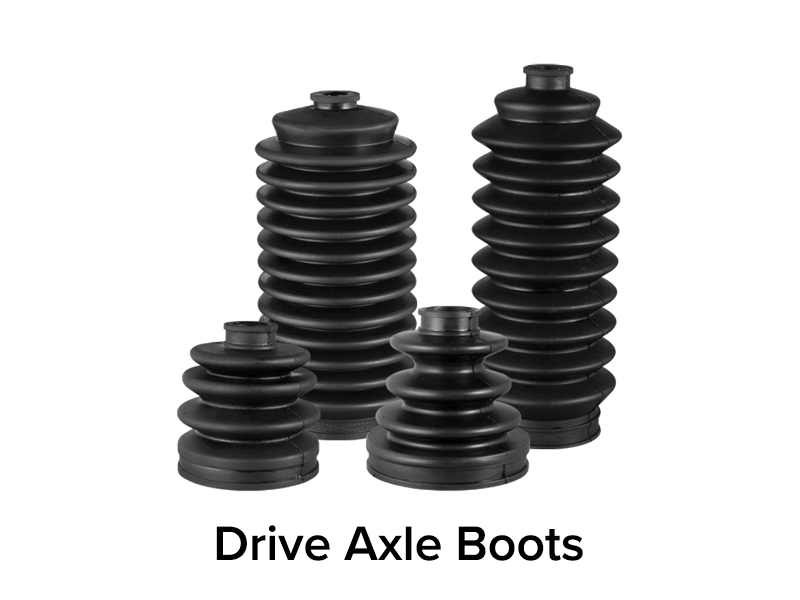

Drive Axle Service
When an axle bearing begins to create a loud and unusual sound, it is typically a sign that the rear axle requires servicing. Whether the axle is about to break or has completely broken, the rear axles must be removed from the vehicle to repair and replace the differential assembly.
Axle seal leaks also warrant a rear axle service that requires the removal of the rear axles themselves. Axle seal leaks can occur from a drive axle boot malfunctioning and can severely damage the axle assembly.
Axle Bearing Service
Bearings in the carrier or on the axles that have become damaged or worn over time will typically produce a constant humming sound. These sounds will occur during acceleration, deceleration, and coasting.
Because the axle must always be removed from the vehicle, the steps in doing so will vary from vehicle to vehicle. As each vehicle's axle configuration may differ, it is important for those servicing axle bearings to consult the vehicle's manual for accurate instructions on how to remove and install an axle properly into the vehicle.
Eye protection should always be worn when removing an axle from a vehicle. During the removal process, it is possible for potential pieces of metal to fly out of the assembly and into the eyes of the servicer.
The collar and bearing should never be removed with a cutting torch, as the heat will result in the axle becoming weakened and damaged. The bearing and collar should never be pressed at the same time. The outer race should never be pressed on as bearing damage and an explosion can result.
Axle Seal Service
Lubricant leaks in the rear axle can occur in several locations throughout the assembly, such as the inspection cover gaskets, the carrier, the pinion gear seal, and the two axle seals. The fluid will appear dark in color and will be oily. These leaks can show up on either the inside of the wheel and brake assembly or below the pinion gear or carrier.
It is easy for drivers to mistake an axle seal leak with a brake fluid leak, or vice versa. One should always touch the wet area and smell it to properly determine whether the fluid is indeed axle lubricant or brake fluid.
New axle seal should always be installed every time an axle assembly is being reinstalled into a vehicle. This should be done even if the seal already installed is fresh, as applying new seal after each removal and installation will ensure that the seal between the axle and axle seal is tight.
A slide hammer puller equipped with a hooknose can be used to remove a housing-mounted seal. The hook is placed on the metal part of the seal, and with an outward jerk of the tool's puller slide, the seal can be properly removed. A large screwdriver may be used as an alternative if a slide hammer puller is unavailable.
The bearing bore in the axle housing will almost always be at risk of being scratched or damaged when removing the seal. It is critical for those servicing a vehicle's axle seal to be cautious when dealing with axle seal removal.

The Cost of Axle Repair
As repairing and replacing an axle assembly on a vehicle can be challenging, it is advisable for drivers to allow a certified mechanic to perform the service. The cost of axle repair service will vary depending on the severity of the issue as well as the vehicle's axle configuration.
Throughout the United States, the average cost of labor for axle repair is approximately $292.10. The average cost for a CV axle replacement is around $639 - $915 depending on the vehicle and parts themselves.
The cost of a CV boot ranges from $19.99 - $54.99 depending on the type of boot, with the cost of labor ranging from $150 - $250. For luxury vehicles, this price may be significantly higher.
Drive Axle Issues
The drive axle assembly is one of the most crucial components of any vehicle. Without an axle, your vehicle will not be able to move at all. If you’re like most curious drivers, you’re probably wondering what happens if your axle breaks while driving, or how long can you drive on a bad CV axle. Driving on a bad car axle can be extremely dangerous and can cause severe and expensive damage to your car if a failing drive axle is not tended to. We will discuss the following issues when it comes to the vehicle axle:
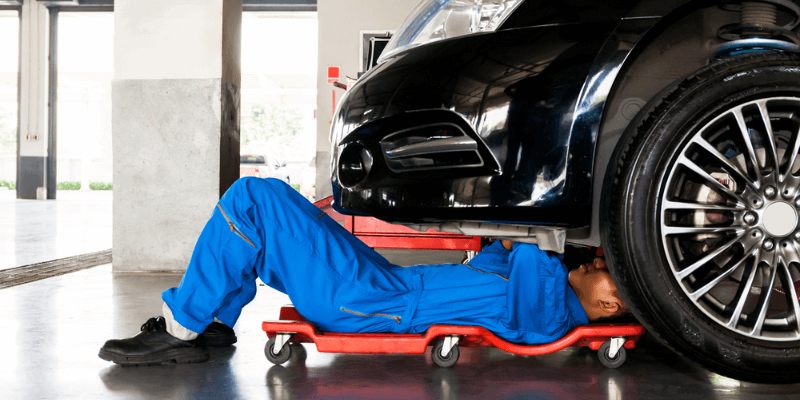
Common Drive Axle Issues
Constant velocity (CV) axles are considered to be drive axles, as they transfer power from the vehicle’s transmission and differential to the wheels. With that said, it’s fairly common to hear about issues surrounding the CV axle shaft and CV joint axle.
Poor Lubrication
The axle joint within the CV axle assembly requires proper lubrication in order to function efficiently. While in motion, these greased joints provide flexibility to the drive axle and allow it to flex according to the road conditions. If your axle joints are not lubricated as they should, it’s likely that the axle will be exposed to high levels of stress and friction; thus, the drive axle will have a higher chance of breaking.
Worn Out Boots
The joints within the axle assembly are covered by a rubber boot, which is commonly referred to as a drive axle boot. These boots protect the lubricated joint from dirt or debris from entering it and sticking to it. These boots have a limited lifespan and become worn out as they are constantly exposed to high levels of stress and friction during normal operation.
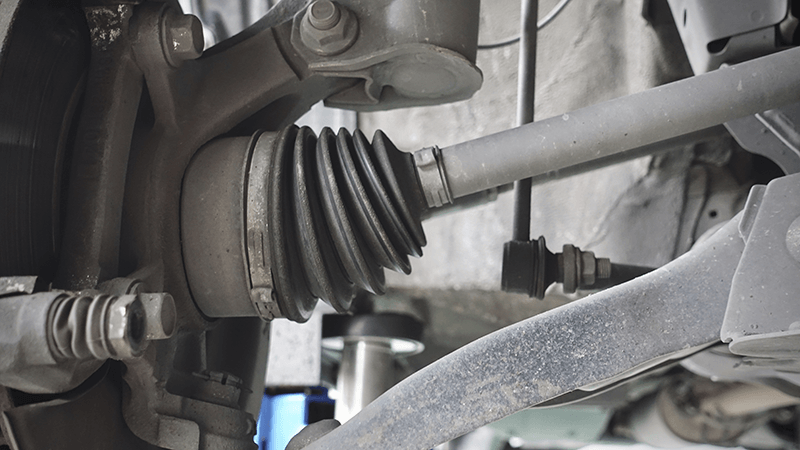
Weight Overload
Most engineers design and build their cars and the axles that go along with them to be able to withstand thousands of pounds (with the help of the suspension) and operate while being exposed to high levels of stress and friction. However, no drive axle is invincible and will inevitably break if too much weight is placed on top of it. Each vehicle will vary in regard to the amount of weight they are able to withstand. The majority of average cars can withstand a load of around 850 pounds (385 kilograms), while industrial trucks can carry more depending on the model of the vehicle.
How to Determine a Car's Weight Carry Limit
The easiest way to determine the weight carry limit of your vehicle is to either refer to the vehicle’s manual or reach out to the manufacturer via the Internet or by phone. Both the manual and the manufacturer will have accurate information according to your vehicle’s model.
If you do not have access to the manual and are unable to contact the manufacturer, look inside of the driver door (sometimes the passenger door) and locate a sticker that lists your vehicle’s tire pressures and gross vehicle weight rating (GVWR). There should be a number along with this data that states the vehicle’s safe working load.
If your vehicle does not have the safe working load listed, find out the curb weight (how much it weighs without any passengers or baggage) of your vehicle. Subtract the GVWR by the curb weight. The result will be the total amount of weight you will be able to safely load into your vehicle.
Symptoms of a Bad Drive Axle
While it’s important to understand the issues that drive axles face, it’s arguably more important to be able to recognize the symptoms of a failing drive axle. Failing to catch a drive axle on its way out can be extremely consequential.
Clicking Sounds
You’ve probably heard a drive axle click while turning, as this is the most common symptom of a failing drive axle. The clicking typically occurs after the axle’s joints have become worn out. Listen closely to which side of your vehicle the sound is coming from in order to determine if the issue lies with the front drive axle or the rear drive axle.
Grease on the Tire
As discussed earlier, the axle’s lubricated joints are covered with rubber boots that protect both the joint and its lubricant. You will most likely notice leaking grease on and around your tires if your rubber boots are wearing out or coming loose.
Vibration While Driving
If your axle shaft or CV joint is going bad, it will not be able to balance efficiently while in motion. As a result, your car will vibrate as you drive and can increase along with your vehicle’s speed. Once the vehicle begins vibrating, this is typically the ultimate sign that your axle will need to be replaced rather than repaired.
The Consequences of Driving on a Bad Drive Axle
A failing drive axle is something that should not be “put off for tomorrow” and should be dealt with as soon as the issue is discovered. Many drivers make the mistake of continuing to drive on a failing drive axle as technically the car is still able to operate. However, if your drive axle breaks while driving, it’s likely that you will end up in a serious accident.
Treating a failing drive axle comes with financial benefits as well. If caught early, components such as the axle boots can be replaced immediately, and you can extend the life of your drive axle overall. This will decrease the chance of a more serious issue developing as a result of operating the axle in the early stages of malfunction.
The Cost of Repairing a Drive Axle
Depending on the severity of the issues your drive axle is facing and the model of your vehicle, the price of repairing or replacing a broken drive axle significantly varies. For example, it may be that your vehicle requires a single joint replacement, a double joint replacement, or an entire front wheel drive axle replacement.
The average price including labor of these parts are as followed:
- Single joint replacement – $200 ~ $400
- Double joint replacement – $350 ~ $1,100
- Axle shaft replacement – $600 ~ $1,100+
Axle replacements can be extremely difficult for the average driver, so it is strongly recommended that you bring your vehicle to a certified mechanic who will be able to properly diagnose the issue and provide you with a safe and efficient solution. Before it comes time to pay the mechanic for the repair bill, look into a drivetrain warranty.

Maintaining a Drive Axle
In addition to paying attention to the sounds a drive axle makes, as well as any fluid that may leak out of it, drivers must be aware of their vehicle's weight limit. Overloading a vehicle will result damaging the drive axle.
Load capacity, or gross vehicle weight rating (GVWR) is typically listed on the interior of the driver's door or in the vehicle's manual. The vehicle's gross axle weight rating (GAWR) and gross axle weight (GAW) must also be taken into consideration. The GAWR can be found in the same locations the GVWR is found in. The GAW should never surpass the GAWR. If a vehicle's tires have either too much or too little pressure, the weight limit can be compromised.
Drivers that have their vehicle's drive axle and its drive axle boots checked during routine maintenance can extend the drive axle's life. When minor issues are caught early, the cost of drive axle repair is typically much lower than severe issues detected later on.
Several examples of maintaining a drive axle have been given in this article. A certified mechanic or a vehicle's manual will provide vehicle-specific information about its drive axle and recommended maintenance techniques.
"> /var/www/dsw/wp-content/themes/DriveSmart_2024_v1.1/pillars/what-is-a-drive-axle/index.php on line 384
">
"> /var/www/dsw/wp-content/themes/DriveSmart_2024_v1.1/includes/quote-modal.php on line 8
">


